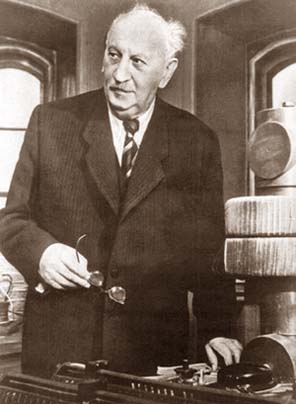
|
|

|
An outstanding Russia's physicist and science organizer, Abram Fedorovich Ioffe was born on October 29, 1880, at the town of Romna, Poltava province (now in the Ukraine). In 1887, having finished the technical secondary school at Romny, he moved to St Petersburg and entered the St Petersburg Technological Institute and the continued his education at the University of Munich under the supervision of one of the best experimenters of that time, Nobel Prize laureate in physics, V.K. Roentgen. In 1905, A. Ioffe defended his doctoral dissertation with excellence and, having declined flattering offers to continue working with Roentgen, returned to St Petersburg. There he started working at the chair of physics of the Polytechnic Institute and became actively engaged in pedagogical activities. |
Ioffe delivered a course of lectures on thermodynamics at the Mining Institute, the theory of radiation at the University, and the general physics at P.F. Lesgaft's courses. At that same time, he became an active member of the Department of physics of the Russian Physicochemical Society and cooperated with an outstanding Dutch physicist-theoretician, P. Ehrenfest, who worked in St Petersburg at that time. In doing so, he did not terminate his investigations commenced in Munich. To this period of time belong his studies of X-rays and electrical properties of insulators, elementary photoelectric effect, magnetic field of cathode rays, and mechanical strength of solids and ways to improve this property. By 1916–1917, talented young physicists from the Polytechnic Institute and University: P.L. Kapitsa, N.N. Semenov, P.I. Lukirskii, Ya.I. Frenkel, Ya.G. Dorfman, N.I. Dobronravov, M.V. Kirpicheva, Ya.R. Shmidt, and K.F. Nestrukha, gradually grouped around A.F. Ioffe. These scientists became the first staff members of the Physicotechnical department at the State Institute of Roentgenology and Radiology, whose organizers included Abram Fedorovich. Now this is the world-known Ioffe Physicotechnical Institute, Russian Academy of Sciences. Being aware of the necessity for bringing the pedagogical and creative-scientific processes in the physical education together to the maximum possible extent, A.F. Ioffe organized in 1919 at the Polytechnic Institute a novel, physicomechanical faculty, working in closest cooperation with the newly organized Fiztekh. The faculty became the prototype of educational institutions of this kind in our country. The successful cooperation of Fiztekh and Fizmekh promoted the rapid development of the domestic fundamental and applied physics. Creative activitiesHaving demonstrated a remarkable scientific foresight as far back as the 1920s, A.F. Ioffe commenced at the Physicotechnical Institute investigations in the most promising, as time has shown, fields of physics: nuclear physics, physics of polymers, and semiconductor physics. There is no need to explain, even to an untrained reader, what fundamental changes in the life of the humankind originated from the discoveries made in these areas of research. Abram Fedorovich achieved an outstanding success in semiconductor physics. His pioneering studies concerned with the mechanism of conduction at the metal–semiconductor interface, theory of thermoelectric generators, and new semiconductor materials and his numerous discoveries are widely known. These investigations gave birth to new areas of research in semiconductor physics, which were successfully developed by his pupils in the following years. The organization of the scientific school was a meritorious Ioffe's service to the science and country. Organizational activitiesThe best practical implementation of the results obtained in basic research and the widest possible dissemination of this knowledge was Ioffe's desire, embodied in, among other things, the organization of Physicotechnical research institutes all over the country: in Kharkov, Urals, and Siberia. Gradually, physics was becoming an all-Union, rather than "metropolitan" science. Former Fiztekh scientists and graduates from Fizmekh were the first staff members of these institutes. Especially brilliant was Ioffe's initiative to create the famous Laboratory no. 2 (the future Institute of Atomic Energy, now Kurchatov Center), where work aimed to create nuclear weapons was commenced in the war years. No less important was his suggestion to make one of his pupils, Igor Vasil'evich Kurchatov, head of the project. Together with Kurchatov, a whole pleiad of Ioffe's pupils of different years played an outstanding role in physics. Among them are Nobel laureates P.L. Kapitsa and N.N. Semenov and academicians A.P. Aleksandrov and B.P. Konstantinov. Now, Abram Fedorovich's grand and great-grand pupils are working at the Physicotechnical Institute, and his ideas in the field of education are being implemented in the training of students coming directly from school to become physicists at the Scientific-Educational Center of the Institute. In the last years of his life, A.F. Ioffe headed the Institute of Semiconductors (in 1972, this institute became part of Fiztekh). AwardsFor his multifaceted activities, A.F. Ioffe was decorated with numerous awards. He was elected a corresponding member of the Academy of Sciences in 1918, and became an academician in 1920. He became an Honored Scientist in 1933 and Hero of Socialist Labor in 1955. A.F. Ioffe was elected an honorary member of numerous national academies, institutes, and societies. For his scientific works, he was awarded a Stalin Prize in 1942 and a Lenin Prize in 1961 (posthumously). |